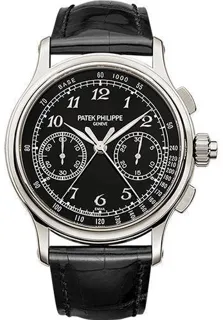PATEK PHILIPPE 10 DAYS GRAND COMPLICATION 5101P
2004
Used, minor to no usage signs
Box: Yes
Documents: Yes
Brand : Patek Philippe
Model : 10 Days Grand Complications Tourbillon
Reference : 5101P-010
Case material : Platinum
Case diameter : 51.7
Glass : Sapphire
PATEK PHILIPPE GRAND COMPLICATIONS TOURBILLON REF. 5101P-010 IN PLATINUM WITH LEATHER STRAP FULL SET WITH ORIGINAL WARRANTY AND BOX YEAR 2004 DIAMETER 51.7MM x 29.6MM Tourbillons are old hat these days. Today, double, even triple axis tourbillons grace the most complex watches—and even crazier stuff besides—but in 2003, they were virtually unheard of. Despite the tourbillon having already been in existence for over two centuries by that point, once the wristwatch took over from the pocket watch, the tourbillon had fallen out of vogue. That is, of course, because a tourbillion serves little purpose in a wristwatch. It's a device that averages out minor imbalances in the beating heart of the movement, a problem that occurs predominantly when a timepiece is orientated in the horizontal position—just like a pocket watch. Wristwatches, however, don't have that problem. It's why automatic movements are a good idea. The 5101P, based on the 5100, was a pioneering watch for Patek Philippe Patek Philippe only exists because of that 'somehow', because of a human fascination with the exquisite. In 2014, researchers at the University of Toronto, following an eight-year-long study that spanned seven countries, discovered that certain shapes, colours, sounds and other stimuli tickle the anterior temporal lobe, the part of the brain that processes object perception and recognition, just right. This in turn triggers the posterior cingulate cortex—the bit that, amongst other things, creates the feeling of satisfaction. We, as a species, are biological predisposed to like this stuff. As well as 10 days of power reserve, the calibre 28-20/222 also has a tourbillon And so, Patek Philippe decided to dig out the plans for an outdated mechanism and made the decision to put a tourbillon in the 5101P. It was no easy task for the 5101P to earn the word 'tourbillon' on the dial. The calibre 28-20/222 started life three years earlier as the 28-20/220, a movement with 10 days of power reserve that was housed in the reference 5100, a watch with very similar proportions to this one. With the two barrels storing all that power taking up most of the space, some drastic structural changes were needed to make the tourbillon fit in the calibre's 20 by 28mm frame. First, the entire going train—the wheels that transfer the power from the source to the hands—was swapped to the dial side of the movement so as not to obscure the tourbillon. Then, the tourbillon itself could be developed. This is the part that houses the escapement and rotates it once per minute to spread the positional errors caused by imbalance. Despite the cage having 72 parts, it only weighs 0.3 grams—about the weight of a matchstick. Only visible through the back, the tourbillon rotates once per minute The really hard part comes in the bit Patek Philippe does best: finishing. Every single one of those 72 parts—plus the rest of the movement, even the bits you can't see, must be finished to the highest standard. Let's not gloss over that sentiment, because it's easy to get caught up in the sensationalism of the terminology; this watch is polished, bevelled, striped and grained—by hand—to a level of quality that cannot be beaten. At all. We see the pressed gold chatons hugging the jewels, the polished screws and uniform Geneva stripes, but it's under magnification that the obsessiveness poured into this movement becomes apparent. Those two cylindrical sections of the tourbillon bridge, for example, are rounded by hand. It takes an experienced master watchmaker two solid days to complete just that tourbillon bridge. It took just three years—a moment in watchmaking terms—to effect this conversion, and just so a handful of watches could be made over its five-year lifespan. And all that work, that landmark of watchmaking excellence, is just hidden away under the dial, the only hint a word written in letters barely a millimetre high—tourbillon. If Patek Philippe released the 5101P today, no one would bat an eyelid. Its reserved art deco styling sits at odds with what we'd expect to see at the cutting edge of horology, where the likes of experimental artisans Greubel Forsey, Urwerk and Richard Mille are to be found. But in 2003, Greubel Forsey didn't even exist, and Urwerk and Richard Mille were still in their infancy; this 5101P, this platinum watch with its diamond-studded chin, salmon-coloured dial and hidden complications, was at the very peak of esoteric. The watch industry is stereotypically understood to be a slow-moving beast, but looking back and seeing this milestone achievement now shows just how far it's come.































